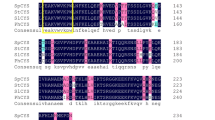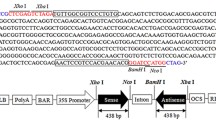Abstract
Key message
Transgenic sugarcane expressing CaneCPI-1 exhibits resistance to Sphenophorus levis larvae.
Abstract
Transgenic plants have widely been used to improve resistance against insect attack. Sugarcane is an economically important crop; however, great losses are caused by insect attack. Sphenophorus levis is a sugarcane weevil that digs tunnels in the stem base, leading to the destruction of the crop. This insect is controlled inefficiently by chemical insecticides. Transgenic plants expressing peptidase inhibitors represent an important strategy for impairing insect growth and development. Knowledge of the major peptidase group present in the insect gut is critical when choosing the most effective inhibitor. S. levis larvae use cysteine peptidases as their major digestive enzymes, primarily cathepsin L-like activity. In this study, we developed transgenic sugarcane plants that overexpress sugarcane cysteine peptidase inhibitor 1 (CaneCPI-1) and assessed their potential through feeding bioassays with S. levis larvae. Cystatin overexpression in the transgenic plants was evaluated using semi-quantitative RT-PCR, RT-qPCR, and immunoblot assays. A 50% reduction of the average weight was observed in larvae that fed on transgenic plants in comparison to larvae that fed on non-transgenic plants. In addition, transgenic sugarcane exhibited less damage caused by larval attack than the controls. Our results suggest that the overexpression of CaneCPI-1 in sugarcane is a promising strategy for improving resistance against this insect.






Similar content being viewed by others
References
Álvarez-Alfageme F, Martínez M, Pascual-Ruiz S, Castañera P, Diaz I, Ortego F (2007) Effects of potato plants expressing a barley cystatin on the predatory bug Podisus maculiventris via herbivorous prey feeding on the plant. Transgenic Res 16:1–13
Broadway RM, Duffey SS (1986) Plant proteinase inhibitor: mechanism of action and effect on the growth and digestive physiology of larval Heliothis zea and Spodoptera exigua. J Insect Physiol 32:827–833
Bustin SA, Benes V, Garson JA, Hellemans J, Huggett J, Kubista M, Mueller R, Nolan T, Pfaffl MW, Shipley GL, Vandesompele J, Wittwer CT (2009) The MIQE guidelines: minimum information for publication of quantitative real-time PCR experiments. Clin Chem 55:611–622
Campos FA, Xavier-Filho J, Silva CP, Ary MB (1989) Resolution and partial characterization of proteinases and α-amylases from midgets of larvae of the bruchid beetle Callosobruchus maculates (F.). Comp Biochem Physiol 92:51–57
Carrillo L, Martinez M, Álvarez-Alfageme F, Castañera P, Smagghe G, Diaz I, Ortego F (2011) A barley cysteine-proteinase inhibitor reduces the performance of two aphid species in artificial diets and transgenic Arabidopsis plants. Transgenic Res 20:305–319
Chen P, Senthilkumar R, Jane W, He Y, Tian Z, Yeh K (2014) Transplastomic Nicotiana benthamiana plants expressing multiple defence genes encoding protease inhibitors and chitinase display broad-spectrum resistance against insects, pathogens and abiotic stresses. Plant Biotechnol J 12(4):503–515
Christensen AH, Quail PH (1996) Ubiquitin promoter-based vectors for high-level expression of selectable and/or screenable marker genes in monocotyledonous plants. Transgenic Res 5:213–218
Companhia Nacional de Abastecimento—CONAB (2016) Acompanhamento da Safra Brasileira de Cana-de-açúcar—Safra 2015/16—Quarto Levantamento. http://www.conab.gov.br/OlalaCMS/uploads/arquivos/16_04_14_09_06_31_boletim_cana_portugues_-_4o_lev_-_15-16.pdf. Accessed on: 20/09/2016
Cristofoletti PT, Ribeiro AF, Terra WR (2005) The cathepsin L-like proteinases from the midgut of Tenebrio molitor larvae: sequence, properties, immunocytochemical localization and function. Insect Biochem Mol Biol 35(8):883–901
Degaspari N, Botelho PSM, Dealmeida LC, Castilho HJ (1987) Biology of Sphenophorus levis, Vaurie, 1978 (Col, Curculionidae), with artificial diet and in the field. Pesquisa Agropecuaria Brasil 22:553–558
Evangelista DE, Fonseca FPP, Rodrigues A, Henrique-Silva F (2015) Pectinases from Sphenophorus levis Vaurie, 1978 (Coleoptera: Curculionidae): putative accessory digestive enzymes. J Insect Sci 15:1–8
Fonseca FPP, Soares-Costa A, Ribeiro AF, Rosa JC, Terra WR, Henrique-Silva F (2012) Recombinant expression, localization and in vitro inhibition of midgut cysteine peptidase (Sl-CathL) from sugarcane weevil, Sphenophorus levis. Insect Biochem Mol Biol 42:58–69
Gallo DN, Neto OS, Carvalho S, Baptista RPL (2002) Entomologia agrícola. Fundação de Estudos Agrários Luiz de Queiroz
Gatehouse JA (2011) Prospects for using proteinase inhibitors to protect transgenic plants against attack by herbivorous insects. Curr Protein Pept Sci 12:409–416
Habib H, Fazili KM (2007) Plant protease inhibitors: a defense strategy in plants. Biotechnol Mol Biol Rev 2:68–85
Haq SK, Atif SM, Khan RH (2004) Protein proteinase inhibitor genes in combat against insects, pests, and pathogens: natural and engineered phytoprotection. Arch Biochem Biophys 431:145–159
Jouanin L, Bonadé-bottino M, Girard C, Lerin J, Pham-delegue MH (2000) Expression of protease inhibitors in rapeseed. In: Michaud D (ed) Recombinant protease inhibitors in plants, pp 179–190
Kessler A, Baldwin IT (2002) Plant responses to insect herbivory: the emerging molecular analysis. Annu Rev Plant Biol 53:299–328
Klein TM, Harper EC, Svab Z, Sanford JC, Fromm ME, Maliga P (1988) Stable genetic transformation of intact Nicotiana cells by the particle bombardment process. Proc Natl Acad Sci USA 85:8502–8505
Koiwa H, Bressan RA, Hasegawa PM (1997) Regulation of protease inhibitors and plant defense. Trends Plant Sci 2:379–384
Lawrence PK, Koundal KR (2002) Plant protease inhibitors in control of phytophagous insects. Electron J Biotechnol 5:93–109
Leplé JC, Bonadé-Bottino M, Augustin S, Pilate G, Lê Tân VD, Delplanque A, Cornu D, Jouanin L (1995) Toxicity tochrysomela tremulae (Coleoptera: Chrysomelidae) of transgenic poplars expressing a cysteine proteinase inhibitor. Mol Breed 1(4):319–328
Livak KJ, Schmittgen TD (2001) Analysis of relative gene expression data using real-time quantitative PCR and the 2−∆∆Ct method. Methods 25:402–408
Murdock LL, Brookhart G, Dunn PE, Foard DE, Kelley S (1987) Cysteine digestive proteinase in Coleoptera. Comp Biochem Physiol 87:783–787
Ninković S, Miljuš-Ðukić J, Radović S, Maksimović V, Lazarević J, Vinterhalter B, Nešković M, Smigocki A (2007) Phytodecta fornicata Brüggemann resistance mediated by oryzacystatin II proteinase inhibitor transgene. Plant Cell Tissue Organ Cult 91:289–294
Nogueira F, Silva CP, Alexandre D, Samuels RI, Soares EL, Aragão FJ, Palmisano G, Domont GB, Roepstorff P, Campos FA (2012) Global proteome changes in larvae of Callosobruchus maculatus Coleoptera: Chrysomelidae: Bruchinae) following ingestion of a cysteine proteinase inhibitor. Proteomics 12(17):2704–2715
OECD (2016) Safety assessment of transgenic organisms in the environment, volume 6: OECD consensus documents, harmonisation of regulatory oversight in biotechnology. OECD Publishing, Paris
Oliva MLV, Carmona AK, Andrade SS, Cotrin SS, Soares-Costa A, Henrique-Silva F (2004) Inhibitory selectivity of canecystatin: a recombinant cysteine peptidase inhibitor from sugarcane. Biochem Biophys Res Commun 320:1082–1086
Outchkourov NS, de Kogel WJ, Wiegers GL, Abrahamson M, Jongsma MA (2004) Engineered multidomain cysteine protease inhibitors yield resistance against western flower thrips (Franklinielia occidentalis) in greenhouse trials. Plant Biotechnol J 2:449–458
Pfaffl MW, Horgan GW, Dempfle L (2002) Relative expression software tool (REST©) for group-wise comparison and statistical analysis of relative expression results in real-time PCR. Nucleic Acids Res 30(9):e36
Rahbé Y, Deraison C, Bonadé-Bottino M, Girard C, Nardon C, Lise Jouanin L (2003) Effects of the cysteine protease inhibitor oryzacystatin (OC-I) on different aphids and reduced performance of Myzus persicae on OC-I expressing transgenic oilseed rape. Plant Sci 164:441–450
Ribeiro AO, Pereira EJ, Galvan TL, Picanco MC, Picoli ET, Silva D, Fari MG, Otoni WC (2006) Effect of eggplant transformed with oryzacystatin gene on Myzus persicae and Macrosiphum euphorbiae. J Appl Entomol 130(2):84–90
Ribeiro CW, Soares-Costa A, Falco MC, Chabregas SM, Ulian EC, Cotrin SS, Carmona AK, Santana LA, Oliva ML, Henrique-Silva F (2008) Production of a His-tagged canecystatin in transgenic sugarcane and subsequent purification. Biotechnol Prog 24(5):1060–1066
Rozen S, Skaletsky H (1999) Primer3 on the WWW for general users and for biologist programmers. In: Stephen M, Stephen AK (eds) Bioinformatics methods and protocols, pp 365–386
Ryan CA (1990) Proteinase inhibitors in plants: genes for improving defenses against insects and pathogens. Ann. Rev. Phytopathol 28:425–449
Santos F, Borém A, Caldas C (2015) Sugarcane: agricultural production, bioenergy and ethanol. Academic Press, London
Soares-Costa A, Beltramini LM, Thiemann OH, Henrique-Silva FA (2002) sugarcane cystatin: recombinant expression, purification, and antifungal activity. Biochem Biophys Res Commun 296:1194–1199
Soares-Costa A, Dias AB, Dellamano M, Fonseca FPP, Carmona AK, Terra WR, Henrique-Silva F (2011) Digestive physiology and characterization of digestive cathepsin L-like proteinase from the sugarcane weevil Sphenophorus levis. J Insect Physiol 57:462–468
Terra WR, Cristofoletti PT (1996) Midgut proteinases in three divergent species of Coleoptera. Comp Biochem Physiol B Biochem Mol Biol 113(4):725–730
Terra WR, Ferreira C (1994) Insect digestive enzymes: properties, compartmentalization and function. Comp Biochem Physiol Part B Comp Biochem 109:1–62
Tribolium Genome Sequencing Consortium (2008) The genome of the model beetle and pest Tribolium castaneum. Nature 452:949–955
Vaurie P (1978) Revision of the genus Sphenophorus in South America. American Museum of Natural History, New York
Vettore AL et al (2003) Analysis and functional annotation of an expressed sequence tag collection for tropical crop sugarcane. Genome Res 13(12):2725–2735
Vorster J, Rasoolizadeh A, Goulet MC, Cloutier C, Sainsbury F, Michaud D (2015) Positive selection of digestive Cys proteases in herbivorous Coleoptera. Insect Biochem Mol Biol 65:10–19
Zhu-Salzman K, Zeng R (2015) Insect response to plant defensive protease inhibitors. Annu Rev Entomol 60:13.1–13.20
Acknowledgements
The research was supported by the São Paulo Research Foundation (FAPESP, CBME, CEPID Proc. 98/14138-2). The authors thank Centro de Tecnologia Canavieira, Piracicaba, São Paulo, Brazil, for essential help in sugarcane transformation. FHS is recipient of a productivity scholarship from National Council for Scientific and Technological Development (CNPq) (##311745/2013-0). V.K.S. and A.S.C.F. received a Grant from FAPESP (2013/05370-0 and 2005/59833-5, respectively), and C.W.R. received a Grant from National Council for Scientific and Technological Development (CNPq).
Author information
Authors and Affiliations
Corresponding author
Ethics declarations
Conflict of interest
The authors declare that they have no conflict of interest.
Additional information
Communicated by P. Lakshmanan.
V. K. Schneider and A. Soares-Costa contributed equally to this work.
Rights and permissions
About this article
Cite this article
Schneider, V.K., Soares-Costa, A., Chakravarthi, M. et al. Transgenic sugarcane overexpressing CaneCPI-1 negatively affects the growth and development of the sugarcane weevil Sphenophorus levis . Plant Cell Rep 36, 193–201 (2017). https://doi.org/10.1007/s00299-016-2071-2
Received:
Accepted:
Published:
Issue Date:
DOI: https://doi.org/10.1007/s00299-016-2071-2




